|
| |
- This page contains pictures and information about Spiny Ants, Strobe Ants and Sugar Ants that we
found in the Brisbane area, Queensland, Australia.
-
 - Spiny Ant
-
- Formicines are generally active and fast moving. They are usually medium in
size, over 5mm in body length. Most species will
defend their nests vigorously, attacking intruders with their large mandibles
and formic acid sprays. They possess poison glands, with which they spray or drip formic acid on their enemies to stun or kill them.
-
 
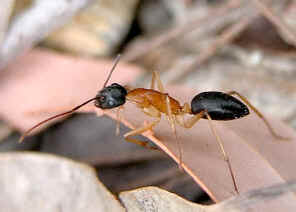 -
Strobe
Ant
Sugar Ant
-
- For the Formicinae ants the petiole is a single segment. The gaster is smooth
and does not have constrictions between the segments. The tip of the gaster is
absent of a sting but with short hairs.
-
- Ants of Dolichoderinae are sometimes confused with species of
Formicinae because both have a single segmented petiole, lack a sting and are often similar in overall body size and shape.
Dolichoderines can be distinguished from formicines as the tip of the gaster has a slit-like opening while formicines have a small circular opening.
-
-
- Golden-tailed Spiny Ant, Elegant spiny ant


 -
Polyrhachis ammon, subgenus Hagiomyrma, body length 10mm
- Those Ants have spines on the mesosoma and the top of the petiole. The
first upper plate of the gaster elongate and comprising more than one-half the
total length of the gaster. The ants are omnivorous and often found collect
'honey dew' from leafhopper and scale-insects. More information and pictures
please find on this page.
-
-
- Black Spiny Ant

 - Polyrhachis (Hedomyrma) .sp., body length 10mm
- We found this Black Spiny Ants nested under loose bark on a large gum tree
trunk. The worker ants have four spines on the mesosoma and the two on top of the petiole.
Please check this page for more information.
-
-
- Large Golden Spiny Ant

 - Polyrhachis sp., body length
16mm
- This ant has the spiny body shape likes the ant above. It is much larger in
size with head and thorax in gold colour. Its abdomen is dark metallic blue.
We saw this ant a few times in in Karawatha Forest. Please check this page
for more information.
-
-
- Rattle Ant, Black Weaver Ant, Dome-backed Spiny
Ant
 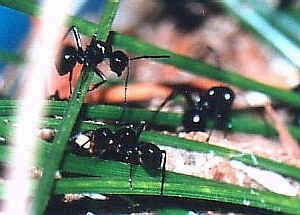  - Polyrhachis australis, subgenus Cyrtomyrma, body length 7mm
- The Rattle Ants are shiny, black in colour, with body length about 7mm. Their
legs and antenna are all black in colour. They are usually found wandering alone
on plants leaves, looking for food. They build nests on trees. If their nest is disturbed, a number of ants will come out looking
for the intruder and make the rattle noise. To see the details of the Rattle
Ants nest please click here.
-
-
- Large Rattle Ant
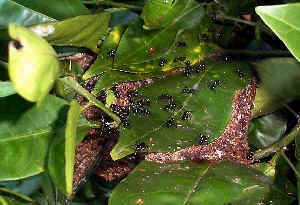 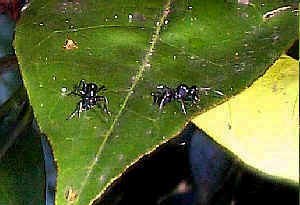 - Polyrhachis sp., subgenus Cyrtomyrma, body length 10mm
- This Large Rattle Ants are shiny, black in colour, and looks exactly same as
the Golden Ants above except they are larger. They are also found wandering alone
on plants leaves, looking for food. They build nest on tree. When their nest is
disturbed, hundreds of ants will come out from the nest and look for the enemy.
We took the above pictures near Lamington National Park on March 2003. The nest was found on an
orange tree about one meter above ground.
-
-
- Very Large Black Ant
 - ? Polyrhachis sp., body length 20mm
- We found this very large black ant wandering on leaves alone. When disturbed,
it posted the attack posture to us.
-
-
- Black-headed Strobe Ant
 
 - Opisthopsis rufithorax, body length 6mm
- Those ants run rapidly with short, jerky motions. They have large eyes on
top edges of their head, with good vision. Their body is bright orange
brown in colour with black head and abdomen tip. They usually found foraging
on forest ground or on
tree trunk. Please also visit this page for
more information.
-
-
- Painted Strobe Ant

 - Opisthopsis pictus, body length 5mm
- This ant look similar to the above species except smaller in size and with
dark waist and legs. We found it alone on tree trunk in Carbrook Wetland on
March 2010. Check this page for more
information.
-
-
- Black-headed Sugar Ant
   - Camponotus nigriceps, body length 10mm
- Camponotus species commonly called sugar ants. Sugar ants are
stingless, although unable to sting, do possess strong mandibles which can
bite. In self-defense these ants are also able to spray acid from their
abdomens to deter predators. More information and pictures please click on here.
-
-
- Banded Sugar Ant, Nocturnal Sugar Ant
  - Camponotus consobrinus, body length 10mm
- Band
As their name imply, they likes sugar, but they are also attracted to any
sweet food. They are omnivores and can be seen foraging on ground in
bush as well as suburban area. More Pictures and information please visit
this page.
-
-
- Orange-tailed Sugar Ant

 - Camponotus sp., body length 10mm
- This sugar ant is orange brown in colour with steel black head. The
abdomen is also orange brown. The ant nest was on ground in soil with a
simple open entrance. Please check this page
for more information.
-
-
- Golden-tailed Sugar Ant


 - Camponotus nigroaneus or C. aeneopilosus, body length 10mm
- Usually a few of these ants were found running slowing on large tree trunk of
smooth bark gumtree. We found one nest Golden-tailed Sugar Ants by turned
over a medium size rock. More information can be found in this page.
-
-
- Small Golden-tailed Sugar Ant
-


- Camponotus sp., body length 6mm
- Small Golden-tailed Sugar Ants are black in colour with a golden abdomen.
They have the relatively smaller head and slim body. Please check this page
for more information.
-
-
- Dark Brown Sugar Ant
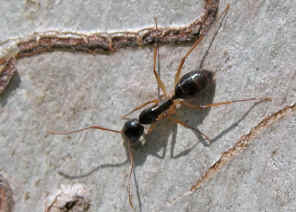
 - Camponotus sp., body length 10mm
- We found this Dark Brown Sugar Ant once on gum tree trunk. We believed
this is in genus Camponotus but we do not know anything about this
ant. Please check this page if we have any updated information.
-
-
- Small Brown Sugar Ant

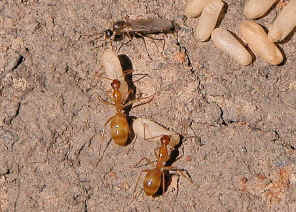 - Camponotus sp., body length 5-10mm
- This Small Brown Sugar Ant is orange brown colour. The workers are found
at least has two body size. Please check this page
for more information.
-
-
- Furnace Ant


- Melophorus sp., workers body length 6-10mm
- We notice this group of ants when a steam of winged class ants coming out
from the nest entry. Please check this page for more pictures and
information.
-
- Reference:
- 1. Insects of Australia and New Zealand - R. J. Tillyard, Angus &
Robertson, Ltd, Sydney, 1926, p290.
- 2. Polyrhachis
(spiny ants) - myrmecos.net,
2005.
- 3. Opisthopsis
(strobe ants) - myrmecos.net,
2005.
- 4. Australian
Camponotus - myrmecos.net,
2005.
-
5. Australian Ants: Their Biology and Identification - S Shattuck, Natalie J Barnett, CSIRO,
1999, p86.
[ Up ] [ Myrmeciinae ] [ Pseudomyrmecinae ] [ Myrmicinae ] [ Ponerinae ] [ Formicinae ] [ Dolichoderinae ] [ Not Known Ants ]
| |
|








































